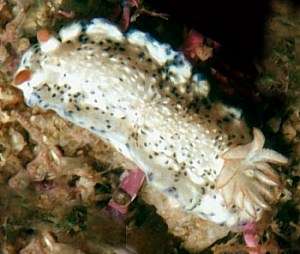
Hypselodoris rudmani
Gosliner & Johnson, 1999
Order: NUDIBRANCHIA
Suborder: DENDRONOTINA
Superfamily: EUDORIDOIDEA
Family: Chromodorididae
DISTRIBUTION
East coast of South Africa.
PHOTO
South Coast KwaZulu-Natal, South Africa. Park Rynie - 28m. May 1999. Size: 25mm. PHOTO: Valda Fraser.
Hypselodoris rudmani is basically translucent, with a reticulate pattern of opaque white, sometimes reduced to whitish spots. There are small black specks/spots scattered over the mantle - but very scarce or absent in the mid region. There is also a row of larger dark blue spots around the mantle edge, which is translucent clear. The gill pockets have unusually raised sheaths, and the rhinophore clubs are orange red. The simple gills are translucent with a thin orange line along the inner and outer edges - sometimes also with some white pigmentation.
-
Gosliner, T.M. & Johnson, R.F. (1999) Phylogeny of Hypselodoris (Nudibranchia: Chromodorididae) with a review of the monophyletic clade of Indo-Pacific species, including descriptions of twelve new species. Zoological Journal of the Linnean Society, 125: 1-114.
Rudman, W.B., 2005 (June 27) Hypselodoris rudmani Gosliner & Johnson, 1999. [In] Sea Slug Forum. Australian Museum, Sydney. Available from http://www.seaslugforum.net/find/hypsrudm
Related messages
Hypselodoris rudmani? from Oman
November 25, 2008
From: Brian Mayes
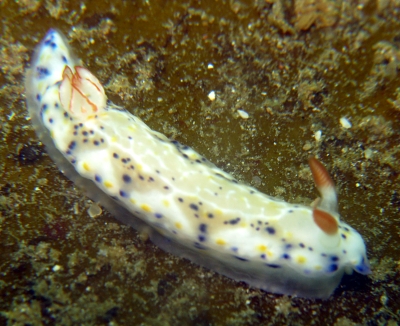
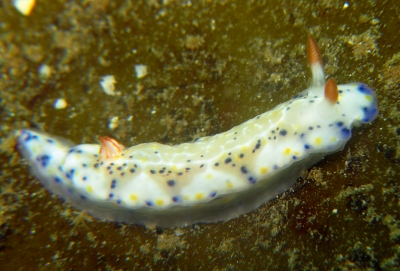
Concerning message #22041:
Hi Bill
Is this nudibranch you namesake Hypselodoris rudmani? It was on a piece of kelp.
Locality: Mirbat, 6 metres, Nr Salalah, Oman, Arabian Sea, 16 October 2008, Sandy bay with coral, rocks and kelp. Length: 30 mm. Photographer: Brian Mayes.
Kind Regards
Brian Mayes
brian.r.mayes@gmail.com
Mayes, B.R., 2008 (Nov 25) Hypselodoris rudmani? from Oman. [Message in] Sea Slug Forum. Australian Museum, Sydney. Available from http://www.seaslugforum.net/find/22067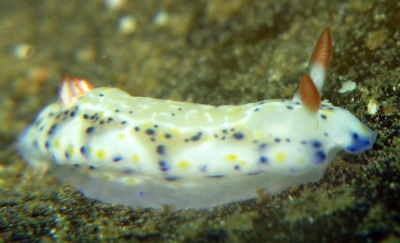
Dear Brian,
Your animal certainly fits the description of H. rudmani, but I don't claim to be an expert on identifying it. It certainly looks very similar to Colin Ogden's photos [message #17554] but as I say in a later message [#19989], H. rudmani has similarities to H. sagamiensis. One feature which is very clear in your photos is the row of inverted triangles along each side of the mantle which are slightly darker than the background colour of the rest of the mantle. One character I used to think was unique to H. infucata was similar triangles which appeared darker than the background colour because they were translucent rather than pigmented. If this is H. rudmani then that species is a very good mimic of H. infucata, or it is in fact a very white pigmented colour form of H. infucata. Clearly I would prefer it to be a good species, but I still think we have some sorting out to do in this colour group of species.
For example in an earlier message from Teresa Zuberbühler [#21614] she has a photo showing a group of animals feeding on a sponge. I identified them as H. infucata but was puzzled by the spots on the gills of the largest specimen which are characteristic of H. kanga. On relooking at that photo I can see that the animal with spotted gills does not have the characteristic inverted triangles while all the others do. On reflection it looks like Zubi's photo shows both H. infucata and H. kanga feeding together. Another puzzle is Binaymin Koretz's photo [message #15795] of a strange colour form of H. infucata from the Red Sea. Perhaps this is H. rudmani?
As you can see, I am not a confident identifier of H. rudmani at present. No doubt as we learn more about these species it will become clearer, but at present I am somewhat cautious.
Best wishes,
Bill Rudman
Re: Hypselodoris rudmani from sthn Queensland?
June 6, 2007
From: Colin Ogden
Concerning message #19985:
Hi Bill,
I have been following Bruce Wilkie's discussion regarding the Hypselodoris sagamiensis and refer to my previous message [#17554]. Could this be a H. sagamiensis as well?
Thanks a ton for the very detailed replies on the C.cavae vs C. tennentana and on the H. maculosa.
Regards Colin
scubaco@iafrica.com
Ogden C. M., 2007 (Jun 6) Re: Hypselodoris rudmani from sthn Queensland?. [Message in] Sea Slug Forum. Australian Museum, Sydney. Available from http://www.seaslugforum.net/find/19989Dear Colin,
I'm glad you are beginning to have heretical thoughts. I have been having similar thoughts myself which leads me to the conclusion that Hypselodoris sagamiensis and Hypselodoris rudmani might just be the geographical extremes of one species. In the original description of H. rudmani there is no mention of a yellow submarginal band down each side of the mantle and I can see none in the accompanying photo which looks very similar to Valda Fraser's photo [#1630]. However your animal [#17554] definitely has a row of submarginal yellow spots which links it to the western Pacific H. sagamiensis.
I can't say I really want to suggest H. rudmani may be just a junior synonym of H. sagamiensis but its a good example of the value of accumulating more records of all these species. I guess we are going to have to rely on you and any of your colleagues in South Africa to find and photograph some more specimens so we can see just what its colour range is in the southwestern Indian Ocean. It would also be interesting to get a photo of its egg ribbon. Nishina Masayoshi has given us an excellent photo [#7720] of the egg ribbon of H. sagamiensis and the relatively large eggs and wavy edge to the egg ribbon are quite unusual. If your South African animal has a similar egg ribbon I would be pretty convinced the two are but one species.
Best wishes,
Bill Rudman
Re: Hypselodoris rudmani from Sodwana Bay, Sth Africa
November 27, 2006
From: Colin Ogden
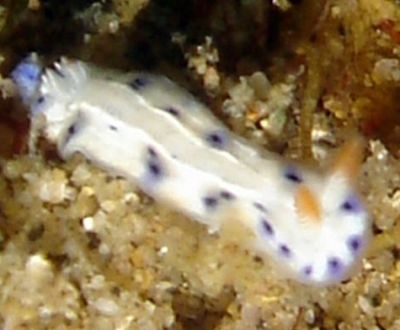
Concerning message #17554:
Hi Bill,
Thanks for your help on the Hypselodoris rudmani. I have queried it before, but the last one seemed more colourful then the one we normally see. Is this a juvenile H. rudmani? It has had me puzzled for a while.
Locality: Sodwana Bay, 16 metres, South Africa, Indian, 16 june 2006, coral reef. Length: 15mm. Photographer: Colin Ogden.
Thanks a ton.
Colin
scubaco@iafrica.com
Ogden C. M., 2006 (Nov 27) Re: Hypselodoris rudmani from Sodwana Bay, Sth Africa. [Message in] Sea Slug Forum. Australian Museum, Sydney. Available from http://www.seaslugforum.net/find/18540Dear Colin,
Often after new species are described there is what could be called a 'settling in' period when we begin to look more closely at similarly coloured animals and try and work out just how much colour variation there is in the new species. Often we have no information on the juveniles, which sometimes may just have some parts of the adult pattern. I guess this specimen and some of the others I have tentatively called H. rudmani fit into that scenario. I suspect this may be a juvenile H. rudmani but there is always the possibility that there are a group of similarly coloured species in southern Africa which we still have to sort out.
Best wishes,
Bill Rudman
Hypselodoris rudmani from Sodwana Bay, Sth Africa
November 9, 2006
From: Colin Ogden
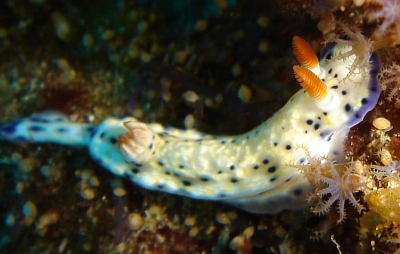
Hi Bill,
I think this is a Chromodoris sp 14. I took these photos on 2 different reefs, both reaonably deep 30 metres and 22 metres. The one photo was in March 2006, and the other in July 2006.
Locality: Sodwana Bay, 30 metres, South Africa, Indian, Mar 2006, Reef. Length: 25mm. Photographer: Colin Ogden.
I have been trying to work out whether they were either Hypelodoris rudmani, or H. cf. maculosa, but the best I can do is the Chromodoris sp 14 from the forum. I would really appreciate your opinion as the sp 14 appears only once since 2002 and that was from Japan, which is a long way from here.
Regards
Colin
scubaco@iafrica.com
Ogden C. M., 2006 (Nov 9) Hypselodoris rudmani from Sodwana Bay, Sth Africa. [Message in] Sea Slug Forum. Australian Museum, Sydney. Available from http://www.seaslugforum.net/find/17554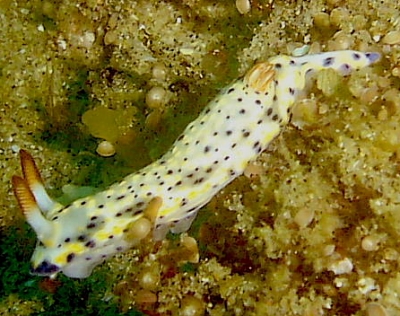
Dear Colin,
I am pleased to say these are Hypelodoris rudmani. I must say we haven't had much luck at finding animals which fit this species well, but I am pretty confident that these are it
Best wishes,
Bill Rudman
Hypselodoris rudmani at last
September 28, 2005
From: Colin Ogden
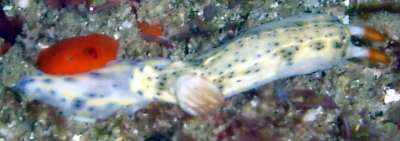
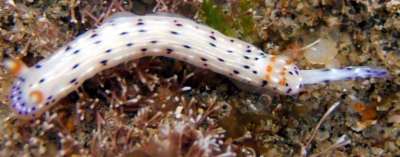
Hi Bill,
At last I think I have managed to find your namesake. This time I am sure it is not a Hexabranchus! [see message #14676 ] The first photo I had on our bikini reef at 22 metres and the second was taken in a rock pool at low tide by Jesse, one of our local non divers who has developed a huge love for nudibranchs and other slugs and spends his free time looking in all the rock pools.
Thanks for your comments [#14810] about the Tambja affinis, I was quite proud of that photo.
Locality: Sodwana Bay, South Africa. Indian Ocean coast. Depth: 22 metres
Length: 25 mm. August 2005. Coral reef. Photographer: Colin & Jesse
Colin Ogden
scubaco@iafrica.com
Ogden C M, 2005 (Sep 28) Hypselodoris rudmani at last. [Message in] Sea Slug Forum. Australian Museum, Sydney. Available from http://www.seaslugforum.net/find/14837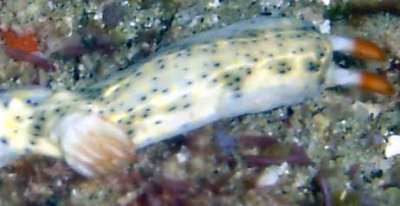
Dear Colin,
I am glad you sent two photos. The upper one certainly seems to be Hypselodoris rudmani, but the lower one is an unnamed animal I am calling Hypselodoris cf. maculosa. I have discussed this in a bit more detail in a separate message [#14850].
Best wishes,
Bill Rudman
Hypselodoris rudmani? from Sulawesi
February 1, 2000
From: Lindsay Warren

Dear Bill
Here is a Hypselodoris or Chromodoris found in the Tukang Besi Islands of SE Sulawesi, Indonesia. (Operation Wallacea) It looks similar to other species in some of the books I have but gills and rhinophores do not match.
This was also found by Graham Abbott in September in 4-5 ft of water on a silty bottom (as shown in the picture) in a channel where the tide flows in and out quite swiftly - it is predominantly a sea grass area but there are isolated coral heads and patches of sponges. L: 8 mm. Photo: Lindsay Warren.
Any clues?
All the best
Lindsay Warren
100014.2112@compuserve.co
Warren, L. , 2000 (Feb 1) Hypselodoris rudmani? from Sulawesi. [Message in] Sea Slug Forum. Australian Museum, Sydney. Available from http://www.seaslugforum.net/find/1824Dear Lindsay,
If this photo had been sent to me from the east coast of South Africa I would have had no hesitation in identifying it as Hypselodoris rudmani. It is almost identical to photo 130 in Gosliner, 1987, except that the blue spots in your photo are larger and quite diffuse around the edges. However at 8mm I suspect your animal was a juvenile. If you look at my photos of the similarly coloured Hypselodoris infucata you will see that in juveniles the blue and yellow spots are proportionally very large, becoming much smaller in adults.
My feeling is that it is Hypselodoris rudmani. If so, your find increases its known distribution from one side of the Indian Ocean to the other.
An interesting find,
Bill Rudman.
Hypselodoris rudmani from South Africa
January 26, 2000
From: Valda Fraser
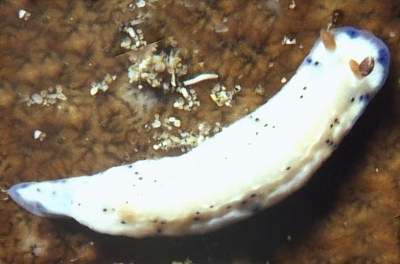
Dear Bill
Has this Hypselodoris been named yet or is it still an "sp?"
Locality: South Coast, KwaZulu-Natal, South Africa. Scottburgh - 25m
Size: 45mm
Date: 20 December 1999
Regards
Valda Fraser
iti04937@mweb.co.za
Fraser, V., 2000 (Jan 26) Hypselodoris rudmani from South Africa. [Message in] Sea Slug Forum. Australian Museum, Sydney. Available from http://www.seaslugforum.net/find/1717Dear Valda,
This is also Hypselodoris rudmani. Hypselodoris sp.2 and Hypselodoris sp. 3 in Terry Gosliner's 1987 South African book are both colour forms of H. rudmani. Your earlier photo is of the form with quite opaque white patches and reticulations.
Best wishes,
Bill Rudman.
Hypselodoris rudmani from South Africa
December 4, 1999
From: Valda Fraser

Dear Bill
Here is another Hyselodoris sp for you. If it's of no interest just throw it away.
Locality: South Coast KwaZulu-Natal, South Africa. Park Rynie - 28m. May 1999. Size: 25mm
Regards
Valda Fraser
iti04937@mweb.co.za
Fraser, V., 1999 (Dec 4) Hypselodoris rudmani from South Africa. [Message in] Sea Slug Forum. Australian Museum, Sydney. Available from http://www.seaslugforum.net/find/1630Dear Valda,
I can't throw this one away! Terry Gosliner and Rebecca Johnson have just kindly named it Hypselodoris rudmani.
Best wishes,
Bill Rudman.
Reference: Gosliner, T.M. & Johnson, R.F. (1999) Phylogeny of Hypselodoris (Nudibranchia: Chromodorididae) with a review of the monophyletic clade of Indo-Pacific species, including descriptions of twelve new species. Zoological Journal of the Linnean Society, 125: 1-114.
